Migrant integration statistics - education
Data extracted on 2 July 2024.
Planned article update: July 2025.
Highlights
In 2023, 35.5% of non-EU citizens aged 25-34 years living in the EU had a tertiary educational attainment compared with 38.8% of citizens of an EU country living in another EU country and 44.2% of nationals living in their own country.
In 2023, the share of early leavers from education and training for young non-EU citizens living in the EU stood at 25.3%; for young citizens of an EU country living in another EU country was 22.8%; and for young nationals living in their own country was 8.2%.
19.3% of non-EU citizens aged 25-64 years living in the EU have participated in learning during the last 12 months prior to the 2022 survey, compared with 18.8% of citizens of an EU country living in another EU country and 25.7% of nationals living in their own country.
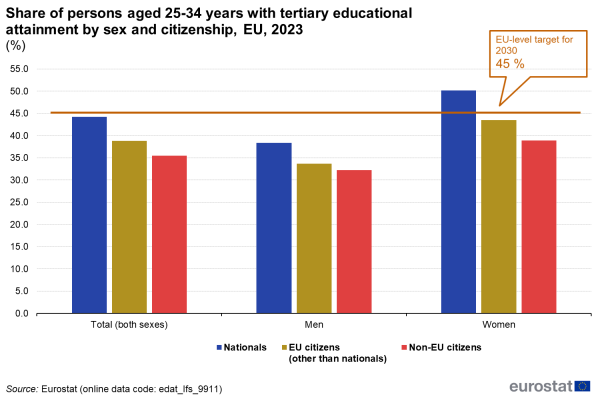
(%)
Source: Eurostat (edat_lfs_9911)
Educational attainment is becoming an increasingly important factor, both in the labour market and for individuals as well as society in general. In the labour market, education is valued by employers when hiring employees. In the coming years it is expected that there will be an increased demand for highly skilled people with the relevant education in order to manage jobs that are more flexible and complex. More generally, having at least an upper secondary education is often considered as the minimum level that helps individuals to be equipped for a full participation in society and to live a fulfilling life.
This article presents European statistics for 3 main education topics: educational attainment, early leavers from education and training and adult participation in learning. The indicators are analysed according to individuals' citizenship: information is presented for 2 categories of foreign citizens (citizens of other EU countries and non-EU citizens) compared with nationals. Eurostat also publishes data by country of birth, which can be consulted in the Eurostat database.
This article forms part of an online publication on migrant integration statistics.
Full article
Educational attainment
An analysis of educational attainment is based on the highest level of education that a person has successfully completed. Educational levels are defined and classified in the international standard classification of education (ISCED). The levels of educational attainment used in this article are based on ISCED 2011.
- A low level of education refers to ISCED levels 0–2 (less than primary, primary and lower secondary education).
- A medium level refers to ISCED levels 3 and 4 (upper secondary and post-secondary non-tertiary education).
- A high level refers to ISCED levels 5–8 (tertiary education, composed of short-cycle tertiary education, bachelor's degree or equivalent, master's degree or equivalent, and doctorate or equivalent).
Figures 1–3 and Table 1 look at the distribution of the population aged 25–74 years according to their level of educational attainment. Figures 4–6 then focus on tertiary educational attainment for a narrower cohort, namely, people aged 25–34 years.
Among nationals aged 25–74 years living in the EU in 2023, more than one-fifth (21.2%) had completed at most lower secondary education, close to half (45.8%) had a medium level of education (i.e. either upper secondary or post-secondary non-tertiary education) and one-third (33.0%) had a tertiary educational attainment (Figure 1).
- By comparison, citizens of other EU countries and non-EU citizens had higher shares of people with at most, lower secondary education (31.1% for citizens of other EU countries and 43.3% for non-EU citizens).
- Citizens of other EU countries and non-EU citizens had smaller shares with a medium level of education (37.4% for citizens of other EU countries and 28.8% for non-EU citizens).
- Concerning tertiary educational attainment, both the shares for citizens of other EU countries (31.5%) and for non-EU citizens (27.9%) were lower than the share observed for nationals.
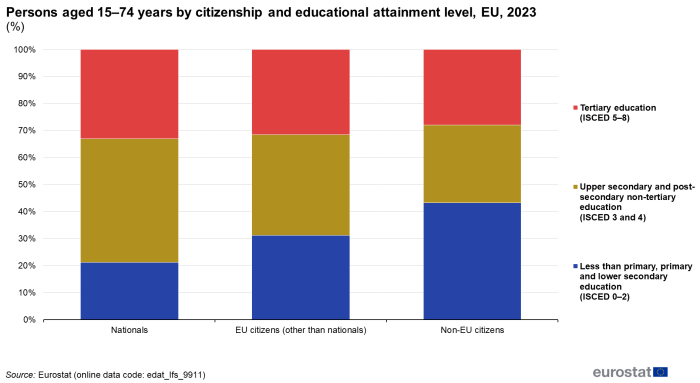
(%)
Source: Eurostat (edat_lfs_9911)
Comparing the distributions according to educational attainment for women with men aged 25–74 years in the EU, 1 common feature can be observed, regardless of citizenship: in 2023, a higher share of women had a tertiary educational attainment than men – see Figure 2. For non-EU citizens, this gender gap was 4.3 percentage points (pp); for nationals, the gap was 3.7 pp and for citizens of other EU countries it was 3.8 pp. By contrast, for all categories of citizenship, a lower share of women had a medium level of education than men. Finally, there was no gender gap in the shares of people having completed at most lower secondary education for nationals, while the shares for men were somewhat higher for citizens of other EU countries and for non-EU citizens.
Comparing EU citizens and non-EU citizens with nationals, the gap in terms of educational attainment in the EU in 2023 was wider for men than for women. For example:
- among men, the share of persons with a low educational attainment was 11.7 pp higher for citizens of other EU countries than for nationals, whereas the gap was 8.1 pp among women;
- among men, the share of persons with high educational attainment was 5.4 pp lower for non-EU citizens than for nationals, whereas the gap was 4.8 pp among women.
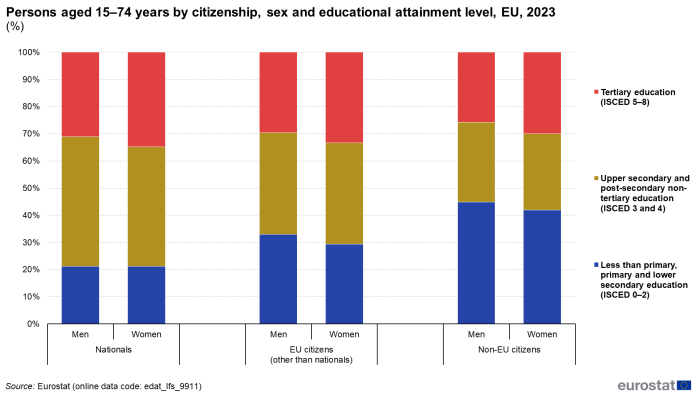
(%)
Source: Eurostat (edat_lfs_9911)
A similar analysis is presented in Figure 3, but with 2 age groups instead of 2 sexes.
Again, the distributions according to educational attainment have common features for the younger (aged 25–54 years) and older (aged 55–74 years) age groups in 2023, regardless of citizenship: in the EU, a larger share of younger people had tertiary educational attainment than did older people. For nationals, this age gap was 16.4 pp; for citizens of other EU countries the gap was 11.5 pp and for non-EU citizens it was 10.1 pp. By contrast, a larger share of older people had completed at most lower secondary education than had younger people, regardless of citizenship. The age gap in the shares of people with upper secondary or post-secondary non-tertiary education was relatively small for all categories of citizenship: there was a slightly larger share for older (rather than younger) people among nationals and citizens of other EU countries while the reverse situation is observed for non-EU citizens.
Comparing EU citizens and non-EU citizens with nationals, the gap in terms of educational attainment in the EU in 2023 was somewhat different for younger and older people.
- For both, low and high educational attainment, the gap was narrower for older rather than younger people, both for citizens of other EU countries and for non-EU citizens.
- For medium educational attainment, the gap was wider for older rather than younger people, both for citizens of other EU countries and for non-EU citizens.

(%)
Source: Eurostat (edat_lfs_9911)
As noted above, nationals aged 25–74 years living in the EU in 2023 were generally:
- less likely than both categories of foreign citizens to have completed, at most, lower secondary education;
- more likely to have a medium level of educational attainment;
- slightly more likely to have tertiary educational attainment.
The average shares for the EU in 2023 reflect a wide range of situations among the EU countries (Table 1).
Comparing the educational attainment distributions in 2023 for nationals with citizens of other EU countries, Ireland and Malta had the opposite situation to that observed for the EU, as nationals had higher shares of people with low educational attainment and a lower share with medium or high educational attainment.
Turning to a comparison of nationals and non-EU citizens, Croatia, Malta and Portugal had the opposite situation to that observed for the EU: nationals had higher shares of people with low educational attainment and lower shares with medium or high educational attainment.
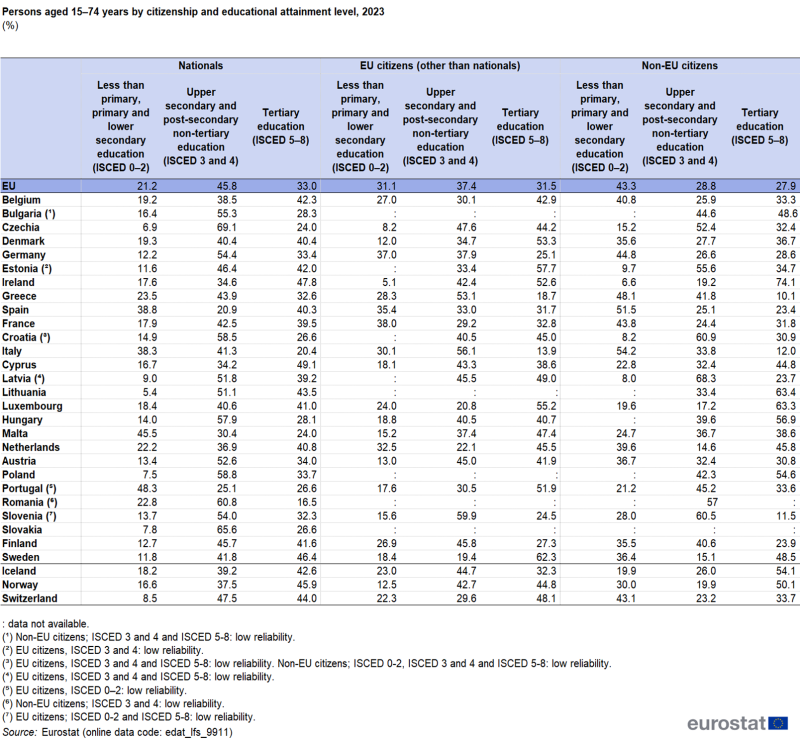
(%)
Source: Eurostat (edat_lfs_9911)
Having successfully completed tertiary education is becoming more important due to the increased demand for highly skilled individuals in the labour market within the European Union. Higher education plays an essential role in society by fostering innovation, increasing economic development and growth, and improving more generally the well-being of citizens.
The last three figures of this section (Figures 4–6) focus on the share of people with tertiary educational attainment, in other words having completed at least one level of tertiary education (ISCED levels 5, 6, 7 and 8). The age coverage is limited to the population aged 25–34 years.
In the EU, the tertiary educational attainment rate for foreign citizens aged 25–34 years was lower than for nationals in 2023 (Figure 4). For citizens of other EU countries, it was 5.4 pp lower, while for non-EU citizens the gap was wider at 8.7 pp. Compared with 2014, the gap for citizens of other EU countries widened while the gap for non-EU citizens narrowed.
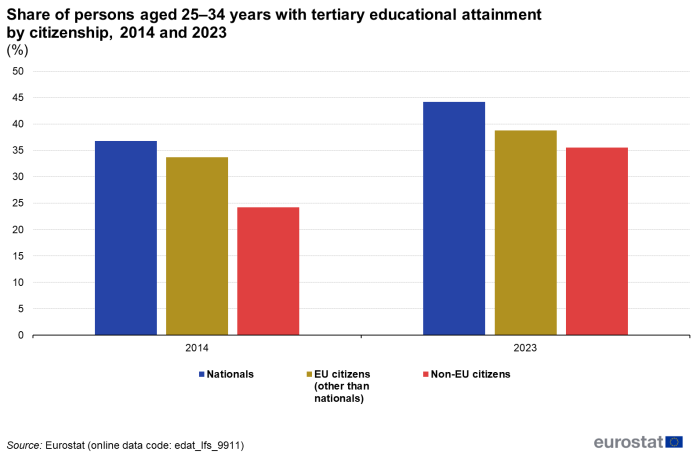
(%)
Source: Eurostat (edat_lfs_9911)
The Resolution on a strategic framework for European cooperation in education and training towards the European Education Area and beyond (known as EEA 2030) set 7 EU-level targets, including that the share of persons aged 25–34 years with tertiary educational attainment should be at least 45%, by 2030. As can be seen from Figure 5, this share was already surpassed in 2023 for women who were nationals, for whom the share was 50.2%. For their male counterparts, the share was 38.4%, in other words 6.6 pp below the target.
- For all 3 categories of citizenship, the tertiary educational attainment shares were higher for women than for men.
- For both, men and women, the tertiary educational attainment share was highest for nationals and lowest for non-EU citizens.
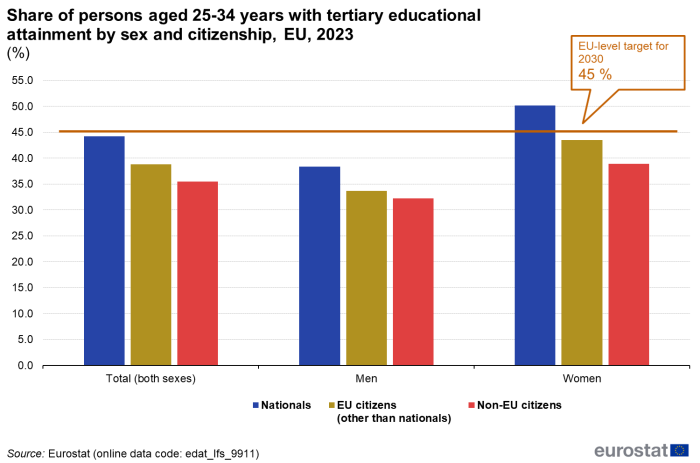
(%)
Source: Eurostat (edat_lfs_9911)
Across the EU countries, the share of people who had tertiary educational attainment varied according to citizenship (Figure 6).
- In less than half (13 out of 27) of the EU countries, the share of nationals aged 25–34 years with tertiary educational attainment in 2023 was already above the target for 2030. This share was largest in Cyprus (71.7%) and smallest in Romania (22.4%).
- Data for EU citizens other than nationals are reliable for 14 EU countries, among which 9 recorded shares above the target. The largest share was 71.8% in Sweden, while the smallest was 15.3% in Italy. In 7 of these 14 countries, the share of citizens of other EU countries with tertiary educational attainment was higher than that for nationals.
- Data for non-EU citizens are reliable for 22 EU countries, among which 9 recorded shares above the target. The largest share was 82.2% in Ireland, while the smallest was 9.5% in Greece. In 8 of these 22 EU countries, the share of non-EU citizens with tertiary educational attainment was higher than that for nationals.
In Czechia and Luxembourg, the share of people aged 25–34 years with tertiary educational attainment in 2023 was lower for nationals than for both categories of foreign citizens.
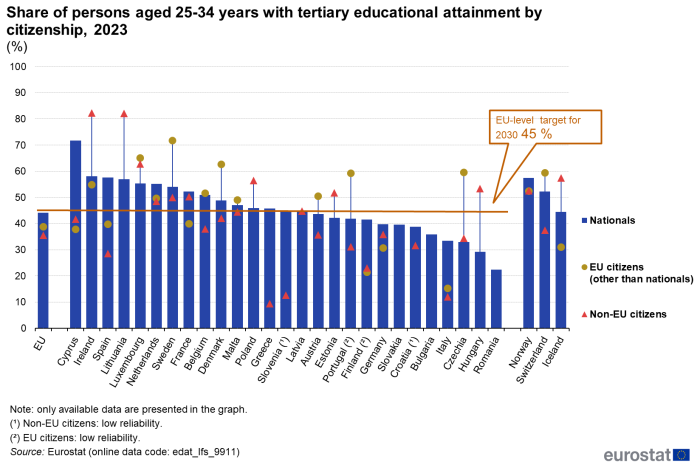
(%)
Source: Eurostat (edat_lfs_9911)
Early leavers from education and training
This section focuses on the share of early leavers from education and training; this indicator is calculated for persons aged 18–24 years. A person in this age group is considered to be an early leaver if their highest level of educational attainment is at most lower secondary education and they have not received any formal nor non-formal education or training in the 4 weeks preceding the survey.
It is important to follow the developments of this group, as early leavers from education and training can face challenges when trying to get established in the labour market. Education has become an increasingly important factor when employers are hiring employees. Leaving education early can also have significant consequences for the individual, as well as for society, in the long term.
In the EU, the share of early leavers from education and training for foreign citizens aged 18–24 years was higher than for nationals in 2023 (Figure 7). For citizens of other EU countries, it was 14.6 pp higher, while for non-EU citizens the gap was wider at 17.1 pp. Compared with 2014, the gap widened for citizens of other EU countries and narrowed for non-EU citizens.
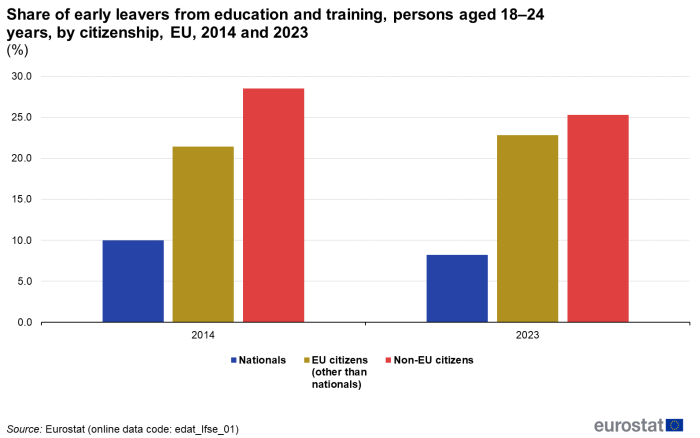
(%)
Source: Eurostat (edat_lfse_01)
One of the 7 targets set by the EEA 2030 foresees that the share of early leavers from education and training in the EU should be less than 9%, by 2030. As can be seen from Figure 8, in 2023, the share of early leavers among young women who were nationals was 6.5%, which is already below this target. For their male counterparts, the share was 9.8%, in other words 0.8 pp above the target.
- For all 3 categories of citizenship, the shares of early leavers from education and training were lower for young women than for young men.
- For both, young men and young women, the share of early leavers from education and training was notably lower for nationals than for the 2 categories of foreign citizens. For both sexes, the highest shares were for non-EU citizens.
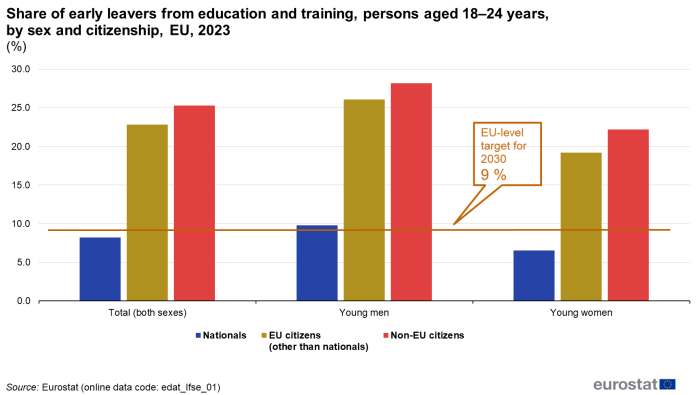
(%)
Source: Eurostat (edat_lfse_01)
Across EU countries, the share of early leavers from education and training for young nationals was lower than for young foreign citizens. This pattern was observed for all the EU countries for which data are reliable. The highest shares were usually recorded for young non-EU citizens, the only exception being Germany, where share of early leavers from education and training was the highest for citizens of other EU countries (Figure 9).
- In 15 of the EU countries (out of 24 with reliable data), the share of nationals aged 18–24 years who were early leavers from education and training was, in 2023, below 9.0%. This share was smallest in Greece (3.3%) and largest in Romania (16.6%).
- Data for EU citizens living in another EU country are reliable for 6 EU countries, among which there was no country recording a share below the target. The largest share was 34.3% in Germany. In all 6 of these EU countries, the share of citizens of other EU countries who were early leavers from education and training was higher than that for nationals; the narrowest gap was 7.4 pp in the Netherlands.
- Data for non-EU citizens are reliable for 8 EU countries, among which there was again no country recording a share below the target. The largest share was 33.0% in Spain. In all 8 of these EU countries, the share of non-EU citizens who were early leavers from education and training was higher than that for nationals; the narrowest gap was 8.5 pp in France.
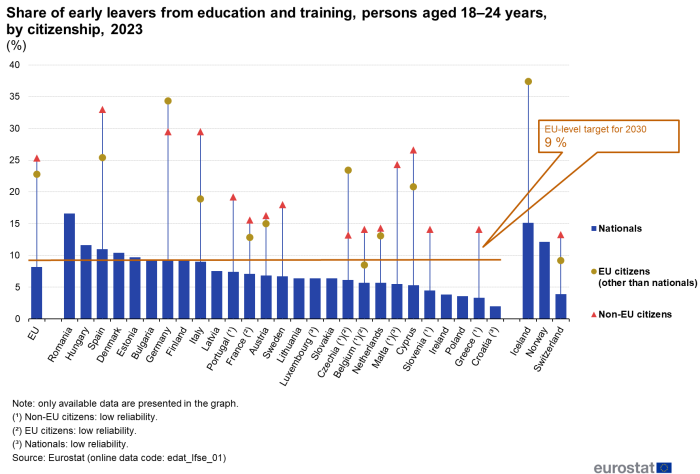
(%)
Source: Eurostat (edat_lfse_01)
One of the criteria for someone to be classified as an early leaver from education and training is if their highest level of education or training was at most lower secondary education. Figure 10 complements Figures 7–9 by showing the share of the population aged 20-24 with at least upper secondary educational attainment – regardless of whether or not they recently received education or training.
The skills and competences gained in upper secondary education are increasingly seen as the minimum credentials for a successful labour market entry as well as the basis for further learning and a fulfilling life.
In 2023, the share of people aged 20–24 years in the EU who had completed at least upper secondary education was 86.3% for nationals. The share was 18.0 pp lower for citizens of other EU countries (68.3%) and 27.6 pp lower for non-EU citizens (58.7%).
- Among the EU countries, the highest shares for nationals were in Croatia, Greece and Ireland, all above 95.0%. The lowest share was in Germany (75.5%).
- Data for EU citizens other than nationals are reliable for 12 EU countries, among which the smallest share was 53.5% in Germany and the largest was 92.8% in Ireland. In 10 of these 12 EU countries, the share of citizens of other EU countries who had completed at least upper secondary education was lower than that for nationals; the exceptions were Denmark and Luxembourg.
- Data for non-EU citizens are reliable for 17 EU countries, among which the smallest share was 50.0% in Germany and the largest was 95.3% in Ireland. In 15 of these 17 EU countries, the share of non-EU citizens who had completed at least upper secondary education was lower than that for nationals; the exceptions were Ireland and Poland.
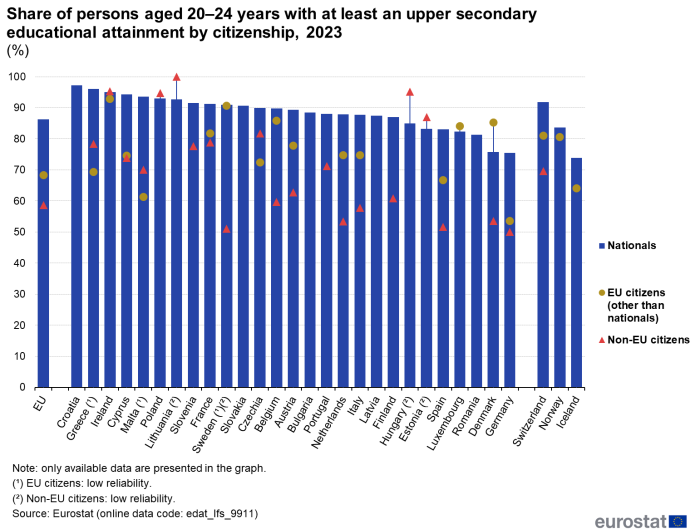
(%)
Source: Eurostat (edat_lfs_9911)
Participation in adult learning in the previous 12 months
The share of people having participated in learning is calculated for persons aged 25–64 years. It is the share of people who participated in formal or non-formal education and training during the 12 months preceding the survey.
Adult learning is an important aspect when it comes to the digitalization and automation in the labour market. Employees need to adapt and for example learn new digital skills and, in some cases, reskill since some jobs will be eliminated due to technical development. Adult learning should improve employability, boost innovation, ensure social fairness and close the digital skills gap.
As can be seen from Figure 11, participation in learning during the previous 12 months was most common in the EU in 2022 (the latest data available) among nationals and least common among citizens of other EU countries. Equally, this share was higher for women than for men, in all categories of citizenship. The highest share was 26.5% among female nationals, while the lowest was among male citizens of other EU countries (18.0%).
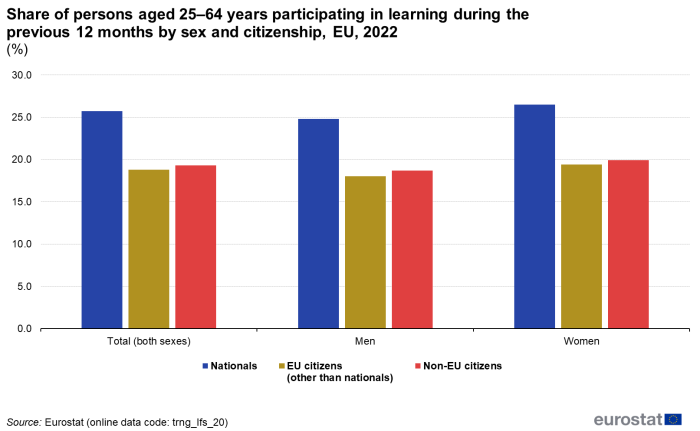
(%)
Source: Eurostat (trng_lfs_20)
In 2022, the share of people aged 25–64 years having participated in learning during the previous 12 months was lower for nationals than for both categories of foreign citizens in Belgium, Ireland and the Netherlands. The reverse situation – a higher share for nationals than for both categories of foreign citizens – was observed in Estonia, Denmark, France, Austria, Spain, Cyprus, Czechia, Italy and Germany (Figure 12).
- In 2022, in Sweden and Estonia, the share of nationals aged 25–64 years participating in learning during the previous 12 months was the highest, above 50%. By contrast, this share was the smallest in Bulgaria (2.8%).
- Data for EU citizens other than nationals are reliable for 16 EU countries, among which Sweden and Malta recorded shares above 50%. The smallest share of 8.1% was in Italy. In 12 of these 16 EU countries, the share of citizens of other EU countries that participated in adult learning during the previous 12 months was lower than that for nationals; the exceptions were Malta, the Netherlands, Ireland and Belgium.
- Data for non-EU citizens are available and reliable for 20 EU countries, among which Sweden and Finland recorded the highest shares above 50%. The smallest share was again in Italy (7.6%). 13 out of these 20 EU countries reported a lower share of non-EU citizens having participated in learning during the previous 12 months than that for nationals; the largest negative difference was in Estonia (18.4 pp). In the remaining 7 EU countries, the share was higher for non-EU citizens than for nationals, with the largest positive difference in Ireland (11.6 pp).
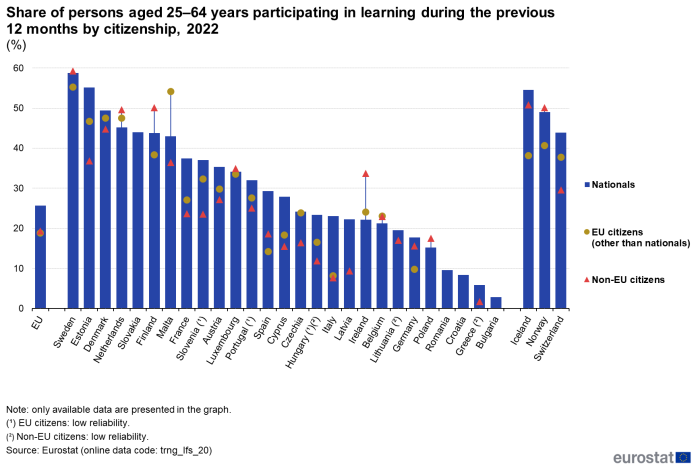
(%)
Source: Eurostat (trng_lfs_20)
Source data for tables and graphs
Data sources
The data presented in this article are from the EU labour force survey (EU-LFS) which is the largest household sample survey in the EU. The survey covers the resident population, defined as all people usually residing in private households. As such, persons living in collective households are excluded from the target population. Usual residence means the place where a person normally spends the daily period of rest, regardless of temporary absences for purposes of recreation, holidays, visits to friends and relatives, business, medical treatment or religious pilgrimage. The data for the EU are aggregated results for the 27 EU countries. For more information on the data sources used, please consult the online publication EU labour force survey.
Due to the sampling nature of the survey, some data have low reliability or are not published due to very low reliability or confidentiality. Data that are of low reliability are duly marked in the footnotes below the figures and tables.
Main concepts
Educational attainment refers to the highest level of education successfully completed. Educational levels are defined and classified in the international standard classification of education (ISCED). The levels of education used in this article are based on ISCED 2011. A low level of educational attainment refers to ISCED levels 0–2 (less than primary, primary and lower secondary education), a medium level refers to ISCED levels 3 and 4 (upper secondary and post-secondary non-tertiary education) and a high level refers to ISCED levels 5–8 (tertiary education).
For the calculation of the tertiary educational attainment rate, the numerator refers to persons aged 25–34 years with tertiary educational attainment (ISCED level 5-8). The denominator is the total population of the same age group, excluding respondents who did not answer the question 'highest level of education or training successfully completed'.
For the calculation of the share of early leavers from education and training, the numerator refers to persons aged 18–24 years who met both of the following 2 conditions: (a) the highest level of education or training they had completed was ISCED 2011 levels 0, 1 or 2 (in other words, at most, lower secondary education) and (b) they had not received any education or training (neither formal nor non-formal) in the 4 weeks preceding the survey. The denominator is the total population of the same age group, excluding respondents who did not answer the questions 'highest level of education or training successfully completed' and 'participation in education and training'.
Since 2022, data on participation in education and training in the last 12 months are collected biennially in the EU-LFS. To calculate the share of people aged 25–64 years participating in learning in the previous 12 months the data for participation in (formal and non-formal) education and training during the 12 months preceding the survey are used. The denominator used for the ratio is the total population (of the same age group), excluding people who did not answer the question concerning participation in (formal and non-formal) education and training. The indicator covers formal and non-formal education and training but excludes informal learning. The fundamental criterion to distinguish learning activities from non-learning activities is that the activity must be intentional (not by chance – 'random learning'), in other words, a deliberate search for knowledge, skills, competences or attitudes.
- Formal education and training is defined as education that is institutionalised, intentional and planned through public organisations and recognised private bodies and – in their totality – constitute the formal education system of a country.
- Non-formal education and training is defined as any organised and sustained learning activities outside the formal education system. This can be further distinguished as:
- non-formal programmes;
- courses (which are further distinguished into classroom instruction, private lessons and combined theoretical-practical courses including workshops);
- guided-on-the-job training (it should be noted that labour force survey data on non-formal education and training do not cover guided-on-the-job training).
- Non-formal education therefore takes place both within and outside educational institutions and may cater for people of all ages. It covers educational programmes and training to impart literacy, life skills, work skills, and general culture.
- Informal learning is less organised and less structured. It is defined as forms of learning that are intentional or deliberate but are not institutionalised. It may include learning events that occur in the family, in the workplace, and in the daily life of every person, for example, coaching/informal tuition, guided visits, self-learning, learning groups or practice. Labour force survey data do not cover informal learning.
Context
In November 2020, an Action Plan on Integration and Inclusion 2021–2027 (COM(2016) 377 final) was adopted with the purpose of fostering social cohesion and building inclusive societies for all. Inclusion for all is about ensuring that all policies are accessible to and work for everyone, including migrants and EU citizens with migrant background. This plan includes actions in 4 sectoral areas (education and training, employment and skills, health and housing) as well as actions supporting effective integration and inclusion in all sectoral areas at the EU, EU country and regional level, with a specific attention paid to young people.
More information on the policies and legislation in force in this area can be found in an introductory article on migrant integration statistics.
The Resolution on a strategic framework for European cooperation in education and training towards the European Education Area and beyond (known as EEA 2030) was agreed by the Council in February 2021. It outlines 5 strategic priorities for the period 2021–2030: improving quality, equity, inclusion and success for all in education and training; making lifelong learning and mobility a reality for all; enhancing competences and motivation in the education profession; reinforcing European higher education; and supporting the green and digital transitions in and through education and training. For monitoring progress, 7 EU-level targets were defined, including that
- the share of persons aged 25–34 years with tertiary educational attainment should be at least 45%, by 2030;
- the share of early leavers from education and training should be less than 9%, by 2030;
- at least 47% of adults aged 25–64 years should have participated in learning during the previous 12 months, by 2025.
Direct access to
Online publications
- Education and training in the EU – facts and figures
- Foreign-born people and their descendants
- Migrant integration statistics
Methodology
- Education (mii_educ)
- Distribution of the population by educational attainment level (mii_edata)
- Early leavers from education and training (mii_edatt1)
- Participation in lifelong learning of population aged 18+ (mii_trng)
- EU labour force survey
- LFS series – Detailed annual survey results (ESMS metadata file – lfsa_esms)
- Migrant integration statistics – methodology
- Action Plan on Integration and Inclusion 2021–2027
- European Commission – Directorate-General for Migration and Home Affairs (DG HOME), see:
- European Commission – Education and training policies
- European Migration Network (EMN)
- European Website on Integration
- OECD – Migration, see:
- UNESCO – Education transforms lives
- UNESCO Institute for Lifelong Learning